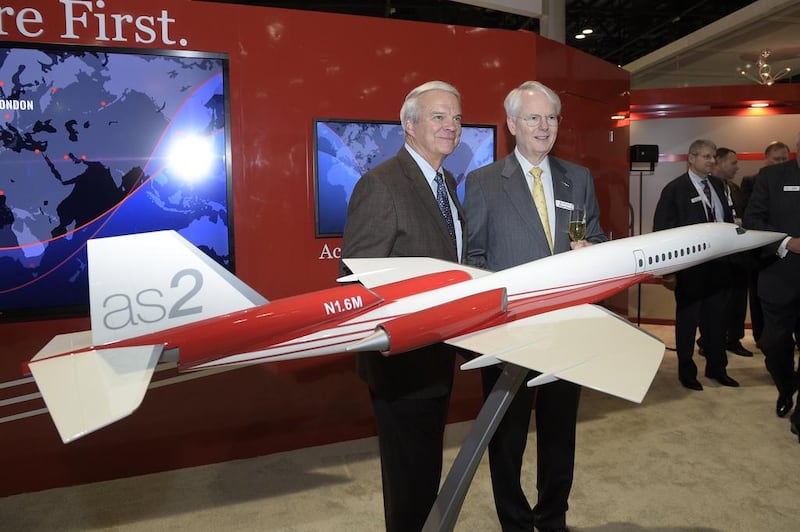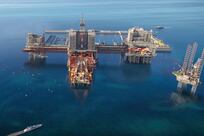For the ultra-wealthy, a Gulfstream 650 or a Bombardier 6000 is fine but, given the choice, most would jump at the chance of their own supersonic luxury jet that could whisk them from Abu Dhabi to London in under four hours, or cut the flight time from Dubai to Singapore by about 2 hours.
And that is exactly what they will be offered once the plane maker Aerion, backed by the Texas billionaire Robert Bass, irons out an engine snag.
The selection of an engine supplier for the plane, a sort of private Concorde, which Mr Bass once said would occur in the first half of this year, is now expected to come in 2017, said Jeff Miller, a spokesman for the Nevada-based company.
Aerion is “making good progress”, Mr Miller said in Orlando, Florida. “We’re taking the time to get to the best decision for all parties.”
Carrying eight to 12 passengers, the AS2 has an intercontinental-capable range of 4,750 nautical miles at supersonic speed, saving three hours across the Atlantic versus subsonic aircraft and more than six hours on longer transpacific routes.
The three-engine jet is due to make its first flight in 2021 and enter service in 2023.
Falling short of the engine goal underscores the difficulty of Aerion’s challenge. The aircraft, known as the AS2, would be the first supersonic civilian plane since Concorde flights were halted in 2003. Aerion’s efforts gained momentum when Airbus agreed in 2014 to help to design and produce the plane, and a fractional-jet ownership company last year ordered 20.
Aerion has considered two dozen engines from various manufacturers, including for civil and military aircraft. The choice is narrowing to a derivative of a civil aircraft power plant that’s already in use, Miller said. He declined to say with whom Aerion is holding discussions.
Supersonic travel is not allowed over the United States and many other countries because of disruption from sonic booms, which occur when a craft exceeds the speed of sound. Aerion plans to operate the jet just below supersonic levels over land and increase velocity over the ocean to Mach 1.5, a speed of some 1,600kph at 35,000 feet.
Of course, to satisfy the demands of the business jetset, the company has spared no expense on the interior.
The initial fleet purchaser Flexjet, the fractional aircraft operator that announced an order for 20 AS2s last year, said it was not privy to the engine negotiations.
“We have examined Aerion’s technology and the AS2’s remarkable performance capabilities, and see them as potential game-changers for business travel. Aerion and Airbus are moving forward impressively with the AS2’s development,” said Kenneth Ricci, the principal of Flexjet owner Directional Aviation.
In December, Aerion appointed Axon Aviation as its exclusive authorised sales representative for Russia.
Axon Aviation, based in Mayfair, London, specialises in transactions involving the very upper end of business jet aircraft.
“Axon Aviation and its partners Kurosh Tehranchian and Niki Rokni have a stellar track record in representing buyers and sellers of the largest business jets. They have earned the confidence of principals and aircraft operators in the Russian Federation,” said Ernie Edwards, Aerion’s chief commercial officer.
Axon said the faster-than-the-speed-of-sound jet would be well received in Russia.
“From Moscow, Axon’s clients can fly nonstop to Seattle, Singapore, Tokyo and Johannesburg, combining high subsonic portions over land and supersonic segments over water,” noted Mr Rokni, who serves as the Axon head of sales. “To cover these vast distances and save hours doing so is pure genius. It creates precious time for the more important things in life and business.”
Mr Tehranchian added: “Our customers are constantly in motion. Aerion calculates that the AS2 can save them up to 17 12-hour work days a year – and that is based on average subsonic aircraft utilisation. Many of our clients fly much more than the average flight department. They will find the AS2 an indispensable mode of travel.”
Mr Ricci said he hoped Aerion would announce an engine choice soon. According to an industry adage, time kills deals.
“The longer these things take to come to fruition the less likely they become,” Mr Ricci said. “We’re hoping they move along.”
chnelson@thenational.ae
with Bloomberg
Follow The National's Business section on Twitter






